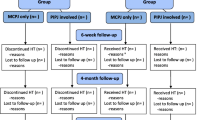Abstract
Background and Objective: Injectable collagenase Clostridium histolyticum is efficacious in correcting Dupuytren’s contracture as assessed by changes in the angle of contracture and range of motion (ROM). However, clinically important changes in ROM have not been evaluated in depth. The objective of this secondary analysis of the CORD I trial was to identify severity levels using baseline ROM, estimate a clinically important difference (CID) for ROM, and link the results to collagenase treatment and patient satisfaction.
Methods: In the CORD I trial, patients with Dupuytren’s disease and joint contractures ≥20° were randomized to receive a maximum of three collagenase 0.58 mg or placebo injections into the cord of the affected hand at 30-day intervals. The primary endpoint was reduction in contracture to ≤5° 30 days after the last injection (day 30). The secondary endpoints, which are reported in this analysis, were ROM, physician- and patient-rated severity (‘normal’, ‘mild’, ‘moderate’, ‘severe’) and improvement, and treatment satisfaction. Linear regression was used to model data for severity classification and CID estimation for ROM based on physician and patient ratings.
Results: At baseline, mean ROM was 43.9° in the collagenase-treated joints (n= 197) and 45.3° in the placebo-treated joints (n= 102). On day 30, mean ROM was 80.7° in the collagenase-treated joints and 49.5° in the placebo-treated joints. The mean increase in ROM was 36.7° in the collagenase-treated joints (p < 0.001) and 4.0° in the placebo-treated joints (not significant). The estimated CID for ROM was 13.5° (95% CI 11.9, 15.1), reflecting a one-category change in severity. The mean increase in ROM exceeded the CID in the collagenase-treated joints but not in the placebo-treated joints; the difference between collagenase treatment and placebo in the mean increase in ROM also exceeded the CID, implying that the improvement with collagenase was clinically relevant. The severity classification for ROM was: ≥67.0°









Similar content being viewed by others
References
Yost J, Winters T, Fett HS. Dupuytren’s contracture: a statistical study. Am J Hand Surg 1955; 90: 568–71
Dias JJ, Braybrooke J. Dupuytren’s contracture: an audit of the outcomes of surgery. J Hand Surg (Edinburgh, Scotland) 2006 Oct; 31(5): 514–21
Ellis B, Bruton A. A study to compare the reliability of composite finger flexion with goniometry for measurement of range of motion in the hand. Clin Rehabil 2002 Aug; 16(5): 562–70
Badalamente MA, Hurst LC. Efficacy and safety of injectable mixed collagenase subtypes in the treatment of Dupuytren’s contracture. J Hand Surg Am 2007 Jul–Aug; 32(6): 767–74
Gilpin D, Coleman S, Hall S, et al. Injectable collagenase clostridium histolyticum: a new nonsurgical treatment for Dupuytren’s contracture. J Hand Surg Am 2010; 35A: 2027–38
Hurst LC, Badalamente MA, Hentz VR, et al. Injectable collagenase clostridium histolyticum for Dupuytren’s contracture. N Engl J Med 2009 Sep 3; 361(10): 968–79
Crosby RD, Kolotkin RL, Williams GR. Defining clinically meaningful change in health-related quality of life. J Clin Epidemiol 2003; 56(5): 395–407
Guyatt GH, Osoba D, Wu AW, et al. Methods to explain the clinical significance of health status measures. Mayo Clin Proc 2002 Apr; 77(4): 371–83
Bennett RM, Bushmakin AG, Cappelleri JC, et al. Minimal clinically important difference in the fibromyalgia impact questionnaire. J Rheumatol 2009 Jun; 36(6): 1304–11
Cappelleri JC, Bushmakin AG, McDermott AM, et al. Measurement properties of the Medical Outcomes Study Sleep Scale in patients with fibromyalgia. Sleep Med 2009 Aug; 10(7): 766–70
Lauridsen HH, Hartvigsen J, Manniche C, et al. Responsiveness and minimal clinically important difference for pain and disability instruments in low back pain patients. BMC Musculoskelet Disord 2006; 7: 82–98
Mulhall JP, King R, Kirby M, et al. Evaluating the sexual experience in men: validation of the sexual experience questionnaire. J Sex Med 2008 Feb; 5(2): 365–76
Coyne KS, Matza LS, Thompson CL, et al. Determining the importance of change in the overactive bladder questionnaire. J Urol 2006 Aug; 176(2): 627–32
Farrar JT, Young Jr JP, LaMoreaux L, et al. Clinical importance of changes in chronic pain intensity measured on an 11-point numerical pain rating scale. Pain 2001 Nov; 94(2): 149–58
Acknowledgements
Editorial support was provided by Linda Goldstein, of UBC Scientific Solutions, and was funded by Pfizer Inc. The CORD I study was sponsored by Auxilium Pharmaceuticals, Inc. The secondary analysis was supported by Pfizer Inc., Groton, CT, USA.
Jörg Witthaut is an investigator for the collagenase Clostridium histolyticum clinical trial programme. Andrew Bushmakin, Robert Gerber, Joseph Cappelleri and Marie-Pierre Hellio Le Graverand-Gastineau are employees of Pfizer Inc., Groton, CT, USA.
Author information
Authors and Affiliations
Corresponding author
Rights and permissions
About this article
Cite this article
Witthaut, J., Bushmakin, A.G., Gerber, R.A. et al. Determining Clinically Important Changes in Range of Motion in Patients with Dupuytren’s Contracture. Clin. Drug Investig. 31, 791–798 (2011). https://doi.org/10.1007/BF03256918
Published:
Issue Date:
DOI: https://doi.org/10.1007/BF03256918




